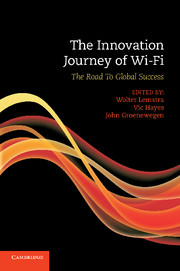Book contents
- Frontmatter
- Contents
- Figures
- Tables
- Contributors
- Preface
- Introduction
- 1 The case and the theoretical framework
- Part 1 The Wi-Fi Journey
- Part 2 The Wi-Fi Journey in Perspective
- 7 Wi-Fi in developing countries: catalyst for network extension and telecom reform
- 8 The Dutch connection to US-based NCR, AT&T, Lucent Technologies and Agere Systems
- 9 Wi-Fi as community-based innovation
- 10 The governance of radio spectrum: licence-exempt devices
- 11 Exploring the future of Wi-Fi
- 12 Reflections and implications for policy and strategy formation
- Part 3 Annexes
- Index
- References
7 - Wi-Fi in developing countries: catalyst for network extension and telecom reform
Published online by Cambridge University Press: 05 June 2012
- Frontmatter
- Contents
- Figures
- Tables
- Contributors
- Preface
- Introduction
- 1 The case and the theoretical framework
- Part 1 The Wi-Fi Journey
- Part 2 The Wi-Fi Journey in Perspective
- 7 Wi-Fi in developing countries: catalyst for network extension and telecom reform
- 8 The Dutch connection to US-based NCR, AT&T, Lucent Technologies and Agere Systems
- 9 Wi-Fi as community-based innovation
- 10 The governance of radio spectrum: licence-exempt devices
- 11 Exploring the future of Wi-Fi
- 12 Reflections and implications for policy and strategy formation
- Part 3 Annexes
- Index
- References
Summary
Introduction
The revolution in telecommunication in the last generation has resulted from the ongoing dynamic interactions between new technologies, new market opportunities and new policies and regulations. One can find examples when the early development of a new technology, such as satellites, provided such obvious evidence of benefit in potential new services and markets that policies and regulations were changed in order to facilitate its application and further its development. There have been occasions when new market demands provided pressure for policy and regulation changes that opened new opportunities for technological development – such as spectrum allocation for wireless services. There have also been times when policy and regulation changes have led the way in creating a foundation for new technological and market development – such as the network unbundling to foster computer communication that facilitated the growth of the Internet. The basic interrelationships are illustrated in Figure 7.1.
If one looks beyond the main events, though, there is evidence that in almost all cases, including those cited above, there have been a series of ongoing dynamic interactions between technology, market and policy developments that gradually opened opportunities wider and wider. Established policies and regulation are unlikely to change unless there is some evidence of potential technological, market and/or social benefit. New services and markets will not be cultivated if technological capabilities and accommodating policies do not exist. New technologies are unlikely to be developed if they cannot be accommodated in policies and markets. Small changes in one factor lead to small changes in another, and, through a series of interactive feedback effects, the small changes provide a foundation for larger ones, and eventually what is then sometimes seen as a revolutionary breakthrough. Although there are barriers to overcome and limiting conditions in all three areas, at any point in time the major limiting condition on the next stage of development may be a technological, economic or policy/regulatory barrier.
Information
- Type
- Chapter
- Information
- The Innovation Journey of Wi-FiThe Road to Global Success, pp. 197 - 229Publisher: Cambridge University PressPrint publication year: 2010
